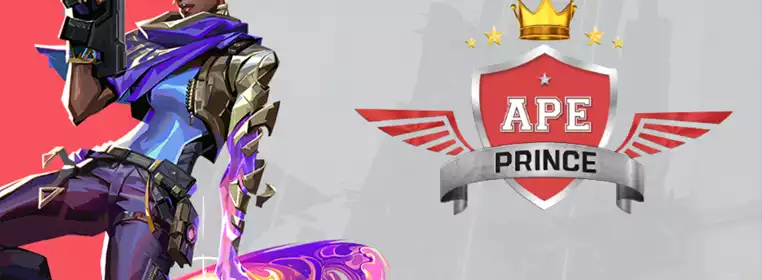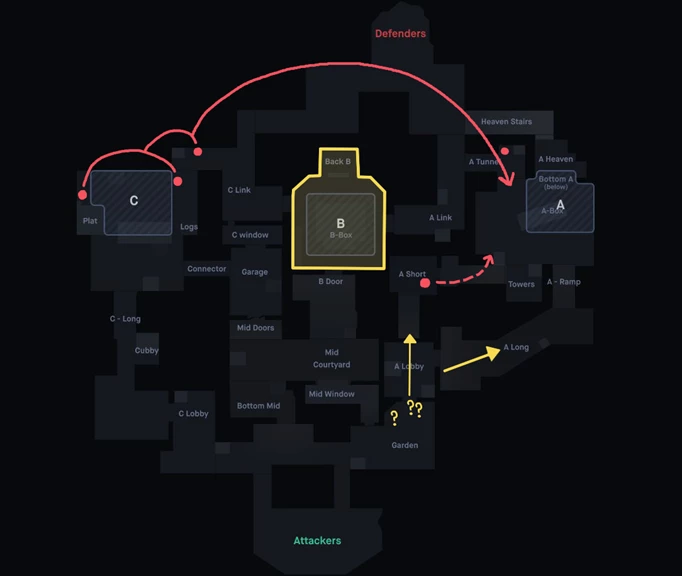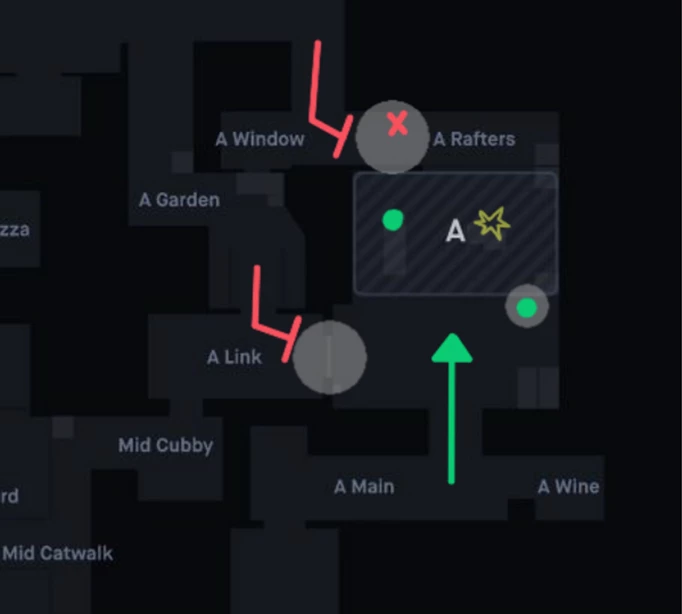What Is The Secret To APE Prince’s Post Plant Setups?

The VALORANT Champions Tour (VCT) is rolling into its inaugural Masters’ event, and South Korea looks primed and ready to perform. After missing the chance to qualify for First Strike South Korea, APE Prince has come into their own recently as a team to be reckoned with. That said, several of their performances have slid under the radar, and a handful of their post-plant setups look incredibly interesting.
We’ve loaded the replays, we’ve cut the film, we’ve looked at a number of APE Prince’s attacking rounds after the spike has been planted and have found some interesting tactics that anyone can apply to their own game.
In two shining examples, APE Prince shows us that defence does not have to mean close proximity to an objective and what happens before the spike is planted is just as important as what happens after.
Down 2-7 against Team MUYAHO on Haven, APE Prince pulls off a brilliant feint play that shows the skeleton of what your typical off-site hold looks like from start to finish.
APE Prince’s spotless set up for their C-Site attack through a shrewd threat of map control and the subsequent fake A-Push allows them nearly perfect resources for their post-plant play. First, they probe up through B-Door, following that they then show their hand towards A-Lobby. These two feints, especially the later one, not only imposes the threat of an attack, but it gives APE Prince vital information.
Their probe into B-Site shows that Killjoy's turret is active; this means she has to be within the area. Once that piece of utility is removed from the map, this asks Team MUYAHO to clear B-Site for fear of a lurking threat. What truly sells the potential threat is Ha "kobra" Su-hyun’s smoke blocking the A-Link angle into B-Site. Without being able to see, MUYAHO has to play with the assumption that there could be some kind of presence entering the site. However, before they have time to react, APE Prince shows towards A-Site.
The feint towards A-Lobby gives them the location of the enemy Jett and Breach. The fact that Jett misses her first Operator shot means she has to give up the space shes created and retreat back towards A-Site. This forces a massive response from the defence as the round timer continues to tick down.
From a defenders point of view, it is difficult to not bite on this fake.
Looking at the round state, there are roughly 39 seconds left for APE Prince to make a play, B-Site could be controlled by the attacking team using it to cut off direct routes towards A, Team MUYAHO knows APE Prince has committed at least three people towards an A-Site hit, and your Operator is not in a strong position to succeed being relegated to playing on A-Site for the time being.
Working with that information, a rotation feels in order.

 Click to enlarge
Click to enlargeWith all of the possibilities, you can’t blame Team MUYAHO for misreading the situation. APE Prince’s patient feints and the threat of map control expertly pulls apart Team MUYAHO’s defence and grants them control of C-Site relatively uncontested. However, as the spike is being planted, both Park "Slash" Jin-sol and Cho "JoXJo" Byung-yeon move down C-Long and begin to position there for the post-plant.
This begs the question; why are Sova and Breach the two agents picked to play off-site? When you look at APE Prince’s composition of Sova, Omen, Killjoy, Jett, and Breach, two agents have the capabilities to support from a considerable range with their utility. Both Sova and Breach can still participate in the defence of C-Site, all the while being wards for any flanking threat wrapping around the attacker’s spawn.
Even though they lose the round to some heroics from Team MUYAHO, most notably, the pick and denial on Killjoy and the final shot from Yu "BuZz" Byung-chul, this is a great outline of how to set up the map to be able to transition players from supporting the entry to gain site control to retaining some map presence while still being within striking distance of the spike itself. Again, just because the round of lost, doesn’t mean the tactics weren’t impressive and something noteworthy.
This is important to keep in mind as we look at another great example of APE Prince’s macro play against DWG KIA on Ascent.

 Click to enlarge
Click to enlargeTo quickly round down the setup, smokes are placed to separate the initial defenders with the reinforcements coming from B-Site. Kim "Halbae" Jun-young tosses a set Nanoswarm grenade towards A-Rafters to further deny a push through the smoke. Yoon "Lawrence" Hyun smokes himself in as Jett to entry, and kobra uses Omen’s ultimate to teleport directly onto the site, which acts both as mobility and scouting for any defender straggling behind the box.
The remaining push plays off a Breach flash covering the back of the site and entry duo’s contact for a fast-paced A-Site take. And again, both Breach and Sova retreat back into A-Main just like their C-Site hold against on Haven. Here they both ward against a lurking threat while still being in practical range of the objective.
While the nuance is absent in this example, many of the same tactics are still in play. Just because an attack is direct and has a high tempo, doesn’t mean it is inherently bad. With this strong initial execute, their post-plant has a cornucopia of resources to be able to pull from.
Looking at the game state, they have multiple ultimates as well as utility that can be used to flood the objective to deny the retake from disarming the spike in time.
While it didn’t net them much value, the Lockdown placed from Halbae has a duel purpose. At worst, it acts as a target dummy for the retake to have to deal with, effectively drawing attention away and forcing a quick action. The best-case scenario has the retake double-back and waits until the ultimate is gone before attacking the objective. His action alone forces DWG KIA to shove out of A-Rafters and quickly remove the ultimate from the table.
Next on the docket, JoXJo’s Rolling Thunder comes in from A-Main to allow kobra an advantage against the initial target on the retake. However, it seems like communication breaks down, and kobra ends up also being stunned by the ultimate, costing him his life.
Then Slash uses his Hunter’s Fury to continue to zone the objective, and unfortunately, much like in their match against Team MUYAHO, some Jett heroics cuts their ability trading and space control out of the picture in one fell swoop. Again, with how much intention is applied to their initial execute, they get to roll into the post-plant with nearly all the resources they could ask for. Could their decision making be slightly tuned? IfLockdown was placed towards A-Main to do a similar job while also being safe, could it be more effective? 100%, but APE Prince has done the hard part; now they just need to refine down the mistakes, and success is sure to follow.
These two plays showcase tangible lessons that anyone can take and implement in their own play, be it structured practice or the ranked ladder.
APE Prince shows us that defending off-site during a post plant scenario is intelligent for a few different reasons, but its application should not be applied generally. What APE Prince shows us is that if you have a numbers advantage over the enemy team or if the plant location has accessible sightlines from your off-site position, then holding onto control of certain parts of the map during post-plant scenarios can be incredibly potent.
The real secret to having a successful post-plant play is to properly set it up. If you can put your initial engagement in a position where it faces little to no threat due to the way you’ve manipulated the map, then you have more resources to work with and more guns to defend the spike with. If the initial play is clean, it all builds up the snowball and bleeds into all aspects of the round.
And last but certainly not least, APE Prince teaches us all one of life’s most consistent truths; friends don’t team stun friends as they’re about to take round deciding duels.
Jokes aside, APE Prince, throughout their qualification into VCT: Masters Korea, has shown both excellent macro play and interesting post-plant situations that anyone can find value in. As long as they refine down some of the mishaps that we’ve seen, they very well could exit Group B with ease and cement themselves as staples in the South Korean VALORANT ecosystem.
Images via Riot Games